Orthodontics as a branch is more concerned with facial growth, development of dentition and occlusion. Knowledge of these helps in better diagnosis and helps in prevention, interception and treatment of skeletal and dental malocclusions. The orthopedic appliances help us in treating the skeletal abnormalities, whereas fixed orthodontic appliances help us in achieving ideal occlusion and help us to maintain functional efficiency, structural balance and aesthetic harmony of orofacial region [1].
Fixed appliances are the most common and versatile appliances used in orthodontics for the dentoalveolar correction, with its main advantage being less demand for patient compliance. In fixed orthodontic treatment, brackets are bonded to the tooth surface to hold the wires for the tooth movement. These brackets are made of different materials such as metal, ceramic and plastic. Placement of stainless steel brackets for orthodontic tooth movement has been a huge concern for patients due to its lack of aesthetic appeal. This demand has led to manufacturing of aesthetic brackets in alternative to metal brackets [2].
The introduction of ceramic brackets revolutionized the concept of aesthetic appliances with its excellent aesthetic appearance and it has the strength to withstand the orthodontic forces. Aesthetic brackets vary according to their optical properties as translucent or non-translucent brackets. Two important clinical implications should be considered while choosing the tooth-coloured brackets: colour matching with the underlying tooth and light transmittance through the bracket which influences the degree of cure of adhesive through the bracket which was an added advantage in ceramic brackets [3].
Bond strength should be good enough to avoid de-bonding during treatment; but at the same time should present less force during debonding without causing any damage to the enamel. It is imperative that the enamel surface be restored as close to pretreatment condition as possible. Hence accurate evaluation of the adhesive remnant plays a crucial role in the final process of enamel cleaning after debonding. Adhesive Remnant Index (ARI), introduced by Artun and Bergland was used to determine the cohesive or adhesive nature of the orthodontic bond [4].
The aim of this study was to evaluate the translucency, intensity and shear bond strength of mono crystalline, polycrystalline and sapphire ceramic brackets by identifying the type of light transmittance and also to assess the ARI score (Adhesive Remnant Index).
Materials and Methods
This was an in-vitro study in which the test for intensity of light transmittance for the ceramic brackets of 26 monocrystalline [Table/Fig-1], 26 polycrystalline [Table/Fig-2] and 26 sapphire [Table/Fig-3] brackets was done in the department of central instrumentation facility, Pondicherry University, Pondicherry. Both the maxillary and mandibular extracted premolars were collected (78 samples) from the Department of Oral Surgery, Indira Gandhi Institute Of Dental Science, Pondicherry, after obtaining the ethical clearance from SBV University. The samples were subjected to test the shear bond strength using INSTRON machine in the department of physics, Annamalai University, Chidambaram. After debonding, evaluation of ARI was done using stereomicroscope at the Department of Oral Pathology, Mahatma Gandhi Post Graduate Institution, Pondicherry. The duration of the study was 2 months.
Monocrystalline ceramic bracket.
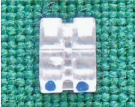
Polycrystalline ceramic bracket.
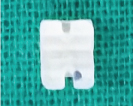
Sapphire ceramic bracket.
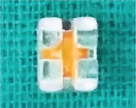
In this present study, the ceramic brackets [Table/Fig-4] were subjected to spectrofluorometer [Table/Fig-5] with a solid sample holder [Table/Fig-6]. The solid sample holder was designed for solids including thin films, powders and pellets. The holder consists of a base upon which a bracket, spring clip and sample block rest. After placing the bracket into the solid sample holder, this unit was locked into the main unit. This was followed by emission of light at longer wavelength of 440nm. The light source was xenon lamp of 450W with a range of 180-1550nm. The xenon lamps were mounted vertically to image the arc on the slide for more through puts.
| S. No. | Brackets | Trade name | Company | Sample size |
|---|
| 1. | Monocrystalline ceramic brackets | Clear | J.J | 26 |
| 2. | Polycrystalline ceramic brackets | Illusion | J.J | 26 |
| 3. | Sapphire Brackets | Radiance plus | A.O | 26 |
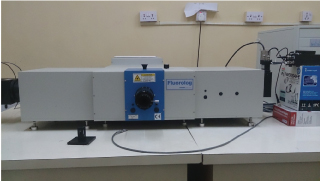
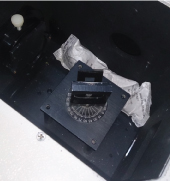
All the 78 premolars procured were cleaned under tap water to remove blood and tissue remnants and cleaned with ultrasonic scaler to remove any tar-tar present on the buccal surface and polished using SMILE AND SHINE polishing kit and stored in distilled water under room temperature. The criteria for tooth selection included intact buccal enamel between the age of 15-30 years (patients approaching for orthodontic treatment is commonly between this age group), of the same geographic location (Pondicherry). Premolars were excluded with pre-treatment chemical agents (e.g. hydrogen peroxide), cracks caused by the extraction forceps, caries and fluorosis.
A blind folded random sampling method was followed. All the 78 samples were numbered one to seventy eight and divided into three groups: G1, G2, G3. The numbering of the samples was done starting from group 1 then group 2 and group 3 and the process was repeated.
To evaluate the shear bond strength of the total 78 samples (26 monocrystalline, 26 polycrystalline and 26 sapphire brackets), the enamel was etched with 37% orthophosphoric acid for 45 seconds and rinsed with water for 30 seconds. A thin layer of light cured adhesive (3M Unitek Transbond XT) was applied to the etched enamel surface and light cured for ten seconds using new light cure unit (Light Emitting Diode) of wood pecker company (400-450nm). Seventy eight 0.022 slot first and second premolar ceramic brackets were bonded with a standard force to secure the bracket on each tooth, using a method described by Maccoll [5]. This process ensured a constant thickness of the composite. The composite was light cured for 40 seconds (10 sec on each side of the bracket). All the samples were stored in distilled water at 370C. The teeth were then embedded into a self curing acrylic resin prefabricated mount of dimension (5cmx4cmx4cm). These samples were subjected to test the shear bond strength using INSTRON machine.
After debonding, evaluation of ARI score was done on all 78 samples (26 monocrystalline, 26 polycrystalline and 26 sapphire brackets) using stereomicroscope in 20X magnification at the department of oral pathology, Mahatma Gandhi Post Graduate Institution, Pondicherry, India.
Results
The study to evaluate the intensity of light transmittance was done using spectro fluorometer where the light is passed through the brackets at certain wavelength (440nm) and the intensity of light which was absorbed was recorded in the graph. The less the absorbtion, the bracket is more translucent. The more the absorbtion, the bracket is opaque [6]. The readings obtained in graphs where x-axis shows wavelength and y-axis shows the amount of light intensity absorbed which is given in CPS (counts per second) [Table/Fig-7,8 and 9].
The average mean absorption values for evaluating intensity of light transmittance for monocrystalline (Group 1) brackets.
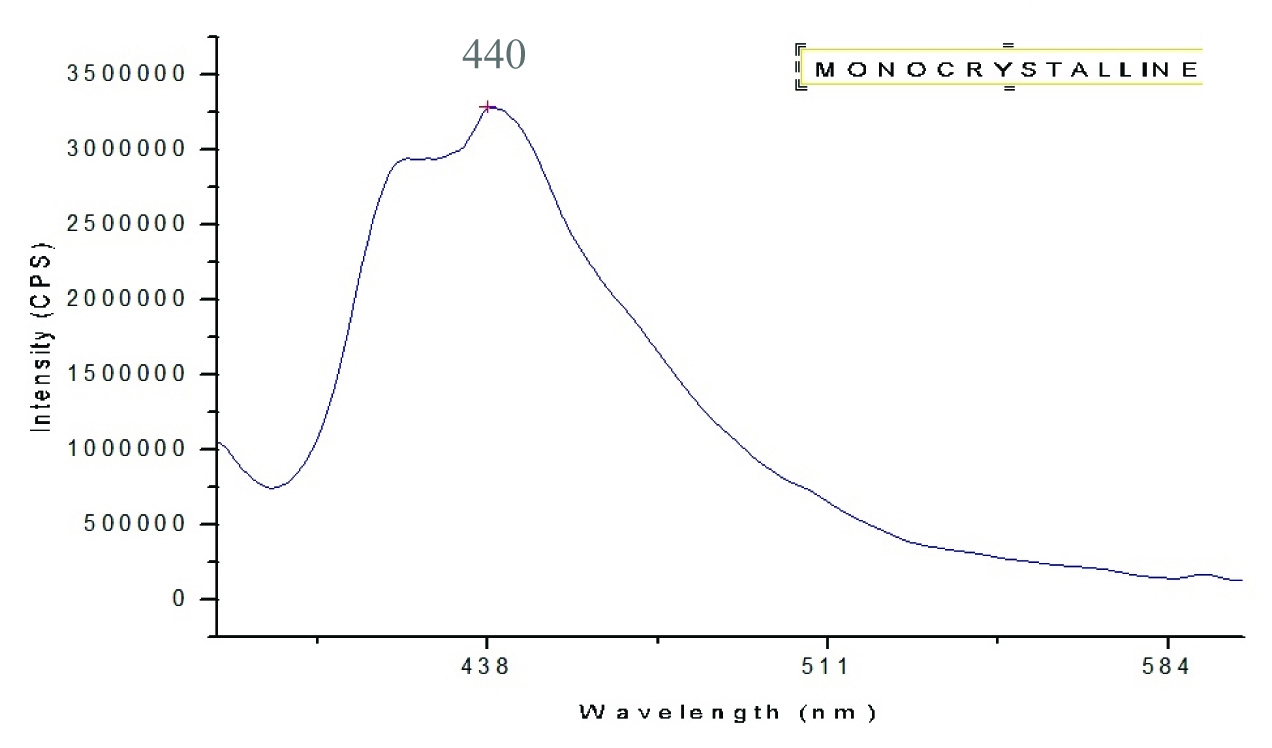
The average mean absorption values for evaluating intensity of light transmittance for polycrystalline (Group 2) brackets.
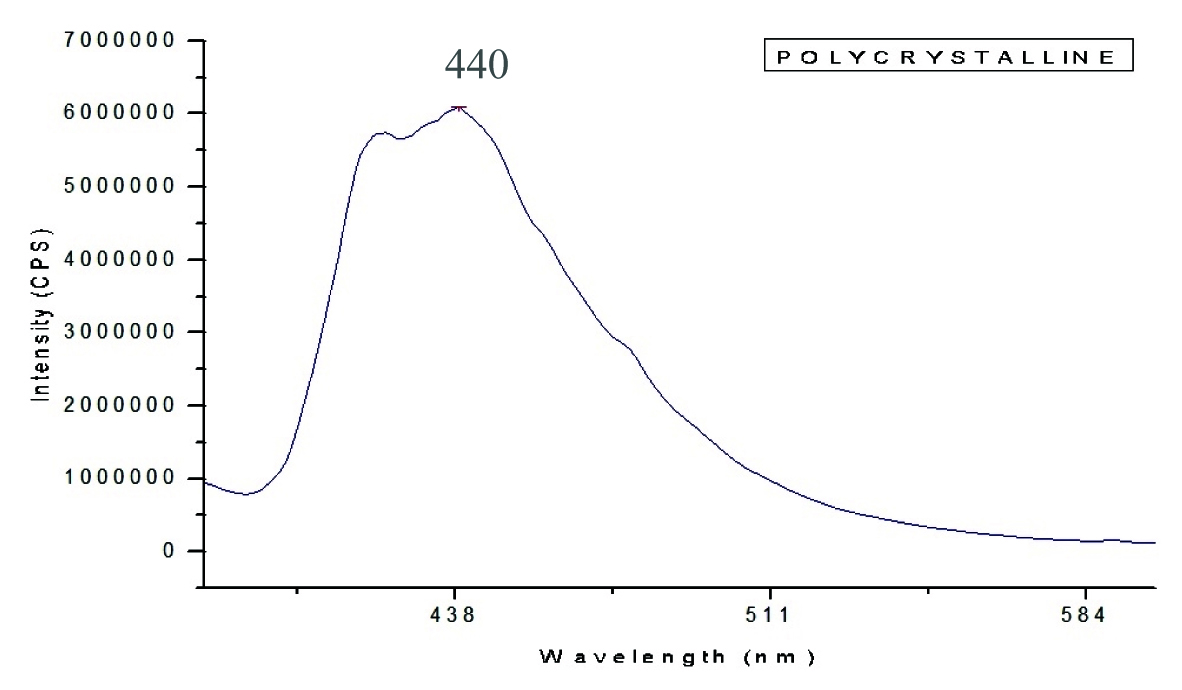
The average mean absorption values for evaluating intensity of light transmittance for sapphire brackets.
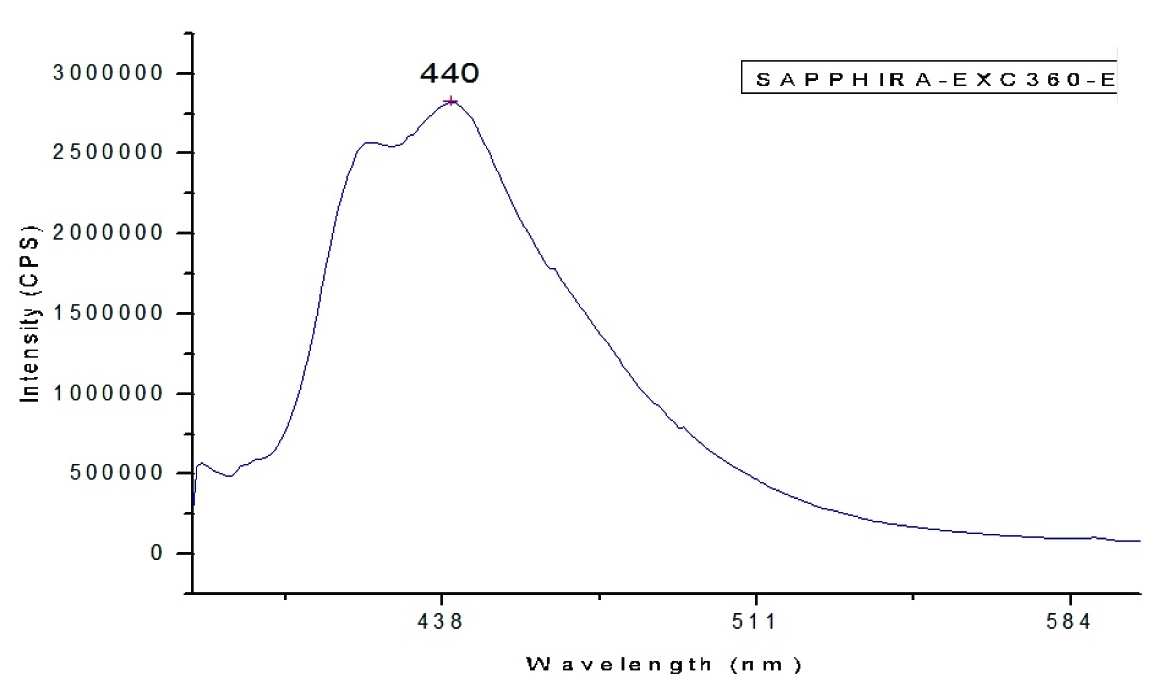
The intensity of light absorption for monocrystalline was around 3300000-3500000 cps (Group 1 – Monocrystalline)
The intensity of light absorption for polycrystalline was around 6000000-6500000 cps (Group 2 – polycrystalline)
The intensity of light absorption for sapphire was around 2700000-3000000 cps (Group 3 – sapphire)
The mean value of all the three groups (Group 1,2 and 3) was compared using one-way ANOVA [Table/Fig-10] and bond strength between the groups was compared with t-test statistical analysis [Table/Fig-11]. These statistics showed that, there was significant difference between the three groups of brackets and also between each two groups.
Comparison of mean values between the groups using one way ANOVA.
| Groups | Mean | N | Std. Deviation | F-value | p-value |
|---|
| Group 1 | 2.450 | 26 | 0.809 | 37.162 | <0.001* |
| Group 2 | 1.900 | 26 | 0.640 |
| Group 3 | 3.667 | 26 | 0.809 |
*denotes statistically significant
Comparison of bond strength between the groups using t-test.
| Groups | Mean difference | N | t-value | p-value |
|---|
| Group 1 vs Group 2 | 0.55 | 26 | 2.718 | 0.009* |
| Group 2 vs Group 3 | -1.767 | 26 | -5.431 | <0.001* |
| Group 1 vs Group 3 | -1.217 | 26 | -8.737 | <0.001* |
*denotes statistically significant
After debonding ceramic brackets, the buccal surface of the tooth and the base of the brackets were analysed using stereomicroscope with 20x magnification and the scores were noted as suggested by Artun and Bergland. The results of the study shows that group 3 exhibited less percentage of adhesive remaining of the enamel surface compared to other 2 groups [Table/Fig-12].
Adhesive remnant index (ARI) score system
| Value | Criteria | Group 1 | Group 2 | Group 3 |
|---|
| 0 | No adhesive left on the tooth | 10 | 5 | 12 |
| 1 | Less than half of the adhesive left on the tooth | 8 | 7 | 10 |
| 2 | More than half of the adhesive left on the tooth | 5 | 9 | 3 |
| 3 | All adhesive left on the tooth, with distinct impression of the bracket mesh | 3 | 5 | 1 |
Discussion
As the proverb says “Beauty is in the eye of the beholder” means different people see beauty in different ways. The art and science of the orthodontics not only helps to improve function, but equal importance is given for aesthetics. As aesthetics plays an important role in self confidence and social acceptability. Level of aesthetic standards have increased day by day because of the patients social considerations and work culture and also because of increased in adult orthodontic patients, so the demand for aesthetics is not only after treatment completion but there is an increased demand for aesthetic appearance during orthodontic treatment. This demand led to the invention of aesthetic brackets such as ceramic, polyurethane and plastic brackets.
The importance of having knowledge on the light transmittance and the intensity is an added advantage to the orthodontist. As day to day procedure are done with light curing unit for attachment of brackets to the enamel surface. The significance of knowledge of light and its intensity is doubled for orthodontists with the ceramic brackets usage. As these brackets are translucent and it allows the light to pass through the brackets which in turn helps in increasing bond strength. But the extent of the light transmittance and its intensity is uncertainty [7]. So in this study we have subjected brackets through the light transmittance and intensity evaluation using spectrofluorometer.
When group 1(monocrystalline) was compared to group 2 (polycrystalline ceramic brackets), the absorption rate of light was much less, indicated that monocrystalline ceramic brackets exhibit superior translucency when compared to the Group 2 (polycrystalline). Due to this translucency and less absorption of light, more curing light passes through the bracket while bonding and this helps us in better bond strength [8,9].
The intensity of light transmittance for polycrystalline showed highest amount of light absorption which may be attributed to its structural complexity. This increased absorption of light prevents the curing light to pass through the ceramic brackets. This may result in decreased bond strength when compared with the other 2 groups.
The test to evaluate the intensity of light for group 3 (Sapphire ceramic brackets) shown the least absorption when compared with the above 2 groups. So this group exhibits superior bond strength because of its translucency. The sapphire ceramic brackets are made up of a single crystal, so the increase in translucency can be attributed to it. Due to the less absorption of light and high transmission, this bracket can be the popular choice of the clinicians. Eliades in 1995 evaluated the reflected and transmitted colours and the diffuse light transmittance of tooth-coloured brackets, which resulted more amount of light transmittance in sapphire brackets [10].
After the intensity for light transmittance was evaluated for brackets, these brackets were bonded to the tooth surface with light cure composite (3M Unitek Transbond XT) as suggested by Depulido et al., with light cure unit of wood pecker company (400-450nm), the test for bond strength was done on instron universal testing machine [11].
The mean value shows that group 3 brackets had increased shear bond strength than group 1 brackets and group 2 brackets. Group 1 brackets have more bond strength than group 2 brackets. Thus group 3 brackets (sapphire ceramic brackets) exhibits superior bond strength and are the brackets recommended for the routine orthodontic treatment, which will have a less bond failure. This may lead in early completion of orthodontic treatment and less chair side timing. Chaconas, Angelo and Gary in 1990 did a Study to determine the shear bond and tensile bond strength of various ceramic brackets [12]. The result of this study showed shear bond strength of monocyrstalline and polycrystalline brackets were affected by bonding systems [13].
After debonding ceramic brackets, the buccal surface of the tooth and the base of the bracket was analyzed using stereomicroscope with 20x magnification. Quantitative analysis of residual adhesive on the tooth surface ARI was done using stereomicroscope with 20x magnification after shearing the bracket and assessed according to Artun and Bergland which is the following: 0 = +No adhesive left on the tooth. 1 = Less than half of the adhesive left on the tooth. 2 = More than half of the adhesive left on the tooth. 3 = All adhesive left on the tooth, with distinct impression of the bracket mesh [14]. Other studies in the orthodontic literature have developed a 5- or 6-point scale. But since this is supposed to be the most reliable method for accessing ARI scores, in this study we have used this method.
According to the Artun and Bergland Adhesive Remnant index criteria [4] for group 1, 10 samples showed no adhesive remaining on the enamel surface out of 26 samples (Value 0), 8 samples showed less than half of the adhesive present on the tooth surface (Value 1). Only 3 samples out of 26 samples after evaluating had exhibited all adhesive left on the tooth and impression of the bracket were found on the adhesive. The overall impression for the group 1 shows increase in bonding between bracket adhesive interface rather than adhesive enamel interface. These results can be due to the structure of monocrystalline brackets which has increased translucency and allows the curing light to pass through the brackets.
After evaluating the ARI score for group 2, the values showed an even distribution between all the values. There is no significant variation in bonding between the bracket adhesive interface and adhesive enamel interface. This may be due to complex structure of the polycrystalline brackets which resists the passage of curing light through the bracket as it has high rate of light absorption.
Evaluation of group 3 shows 12 samples showed no adhesive left on the tooth surface which indicates increased bond between adhesive bracket interfaces. And 10 samples shower less than half of the adhesive left on the tooth surface and only 1 sample showed value 3, that is all the adhesive left on the bracket. This result suggest that sapphire brackets is also a monocrystalline bracket but with increased strength and translucency when compared with the monocrystalline ceramic brackets. This increase in translucency helps in passage of more amount of light which directly influence the curing of adhesive in bracket adhesive interface. This increase in translucency helps in achieving maximum bond strength in ceramic brackets. Leily Macedo Firoozmand in 2013 suggested that sapphire brackets have more strength with composite [15]. The clinicians can be advised to use sapphire ceramic brackets which have provided greater bond strength compared to other two ceramic brackets used in this study. This type of study can be further done to estimate the bond strength and ARI score in intra oral conditions.
Conclusion
Sapphire ceramic brackets exhibited high translucency with less light absorption. This property helps in increased passage of curing light through the bracket which showed high shear bond strength. ARI scores also suggested increased bond between bracket and adhesive interface in sapphire ceramic brackets. So I would like to conclude this study that sapphire brackets exhibited superior qualities such as translucency and bond strength.
*denotes statistically significant
*denotes statistically significant